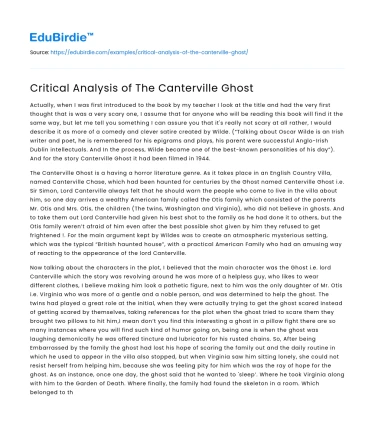Introduction
Oscar Wilde's novella, The Canterville Ghost, presents a multifaceted narrative that intricately weaves elements of comedy, horror, and social commentary. First published in 1887, the story revolves around an American family, the Otises, who move into the haunted Canterville Chase, much to the chagrin of its resident ghost, Sir Simon. Unlike traditional ghost stories that rely heavily on generating fear, Wilde's tale subverts these expectations by blending satirical humor with supernatural elements to explore themes of cultural clash, redemption, and the human condition. This essay critically analyzes the narrative structure and thematic depth of The Canterville Ghost, examining how Wilde employs literary devices to challenge societal norms and question the nature of human interactions. Through an exploration of character dynamics, thematic contrasts, and Wilde's unique use of satire, the story emerges as a timeless commentary on cultural and moral values.
Cultural Clash and Satirical Humor
A central theme in The Canterville Ghost is the cultural clash between the American Otis family and the quintessentially British ghost, Sir Simon. Wilde juxtaposes American pragmatism and British tradition, using this cultural dichotomy to generate humor and critique societal norms. The Otis family, emblematic of modernity and rationalism, approaches the supernatural with a practical mindset, often to comedic effect. For instance, when Mrs. Otis encounters the ghost, her immediate response is to offer him a bottle of Tammany Rising Sun Lubricator to oil his chains, showcasing a humorous disregard for the spectral presence. This behavior is indicative of the American ethos, characterized by a lack of reverence for historical and supernatural traditions.
Save your time!
We can take care of your essay
- Proper editing and formatting
- Free revision, title page, and bibliography
- Flexible prices and money-back guarantee
Sir Simon, on the other hand, represents the old-world aristocracy, bound by his duty to haunt Canterville Chase. Wilde uses Sir Simon's character to satirize the English aristocracy, portraying him as both pitiable and absurd. His attempts to terrify the Otis family result in repeated failures, further lampooning the futility of clinging to outdated customs in the face of modernity. Literary critic Richard Ellmann notes that Wilde’s satire “extends beyond the ghostly to critique the rigidity of British social structures.” By employing humor to underscore cultural differences, Wilde not only entertains but also invites readers to reflect on the absurdity of rigid adherence to tradition.
The interplay between the Otis family and Sir Simon serves as a microcosm of the larger cultural conflicts of Wilde's time, highlighting the tension between innovation and tradition. This satirical examination of cultural identities underscores the novella's enduring relevance, as it mirrors contemporary discussions about globalization and cultural assimilation. As readers navigate the humorous interactions, they are prompted to consider the broader implications of cultural exchanges and the potential for mutual understanding.
Redemption and Humanization of the Supernatural
Beyond its satirical elements, The Canterville Ghost delves into themes of redemption and humanization, portraying the ghost not merely as a source of humor but as a complex character capable of emotional depth. Sir Simon's transformation from a malevolent spirit to a sympathetic figure is central to the narrative's emotional resonance. Initially, Sir Simon is depicted as a traditional ghost, intent on haunting the Otis family. However, as the story progresses, Wilde reveals his vulnerability and longing for peace, challenging preconceived notions of the supernatural.
The character of Virginia Otis plays a pivotal role in Sir Simon's redemption. Her empathy and willingness to understand the ghost's plight mark a departure from her family's pragmatic approach. In a poignant dialogue, Sir Simon confesses his remorse and desire for eternal rest, a sentiment that Virginia acknowledges with compassion. Wilde uses this interaction to explore the theme of forgiveness, suggesting that understanding and empathy can transcend cultural and temporal boundaries. As literary scholar Peter Raby asserts, “Virginia’s compassion is the key to unlocking Sir Simon’s soul, allowing him to find peace.” This narrative arc not only humanizes the ghost but also reinforces the idea that redemption is attainable through genuine connection and understanding.
Wilde's portrayal of Sir Simon challenges the stereotypical depiction of ghosts in literature, presenting him as a tragic figure trapped by his past actions. This nuanced characterization encourages readers to consider the complexities of the human condition, where past transgressions can be reconciled through acts of kindness and empathy. By transforming the ghost into a symbol of redemption, Wilde invites readers to reflect on their own capacity for forgiveness and change, underscoring the novella's universal appeal.
Conclusion
In conclusion, Oscar Wilde's The Canterville Ghost is a masterful blend of humor, horror, and social critique, offering a profound exploration of cultural dynamics and human redemption. Through its satirical examination of the cultural clash between the American Otis family and the British ghost, Wilde challenges readers to question societal norms and the value of tradition. Additionally, the narrative's focus on Sir Simon's redemption underscores the potential for empathy and understanding to transcend cultural and temporal divides. Wilde's ability to humanize the supernatural and infuse the story with humor and pathos ensures its enduring relevance in literary discourse. Ultimately, The Canterville Ghost is not merely a tale of spectral hauntings but a reflection on the complexities of human interactions and the transformative power of compassion.






 Stuck on your essay?
Stuck on your essay?

